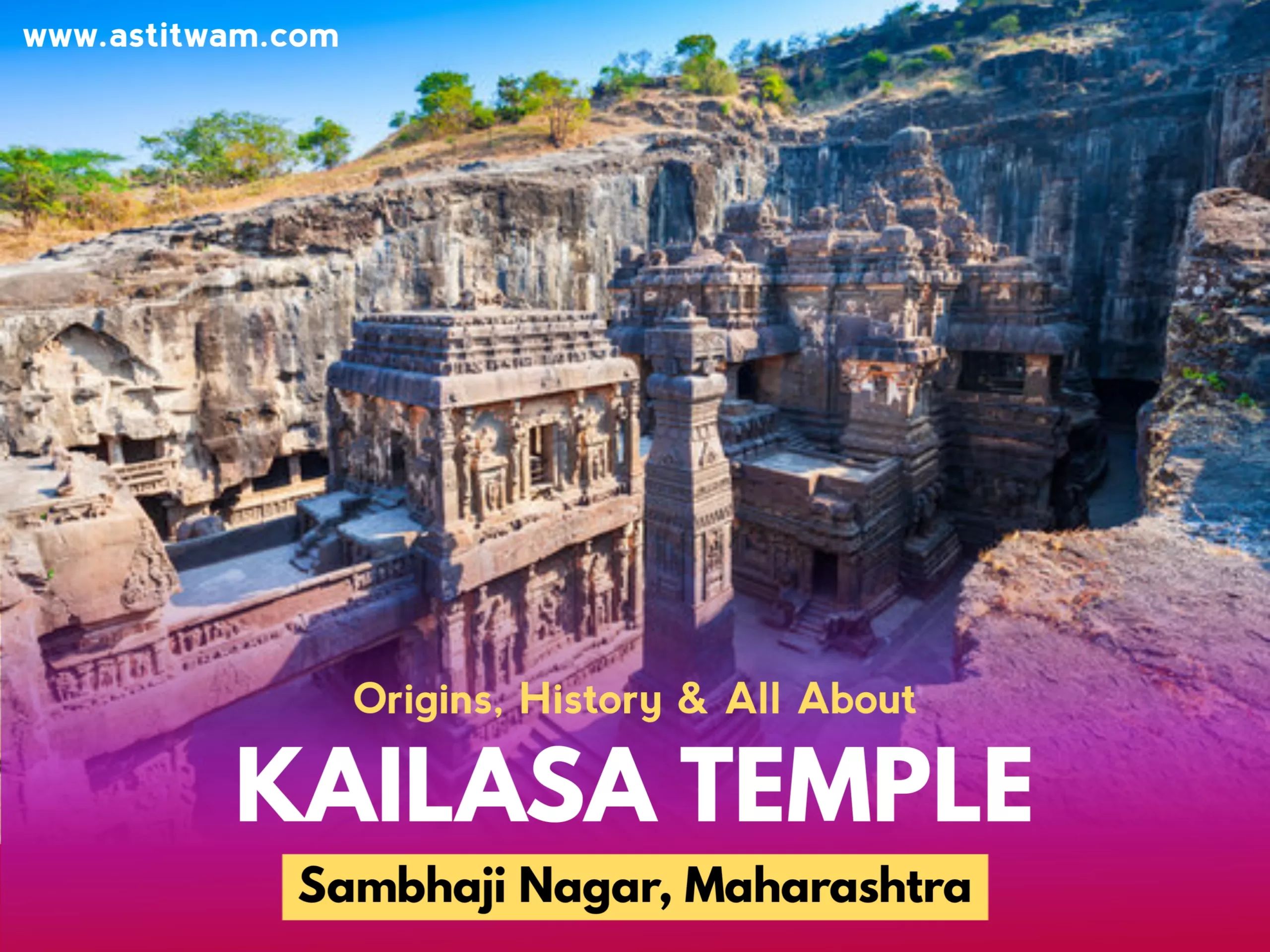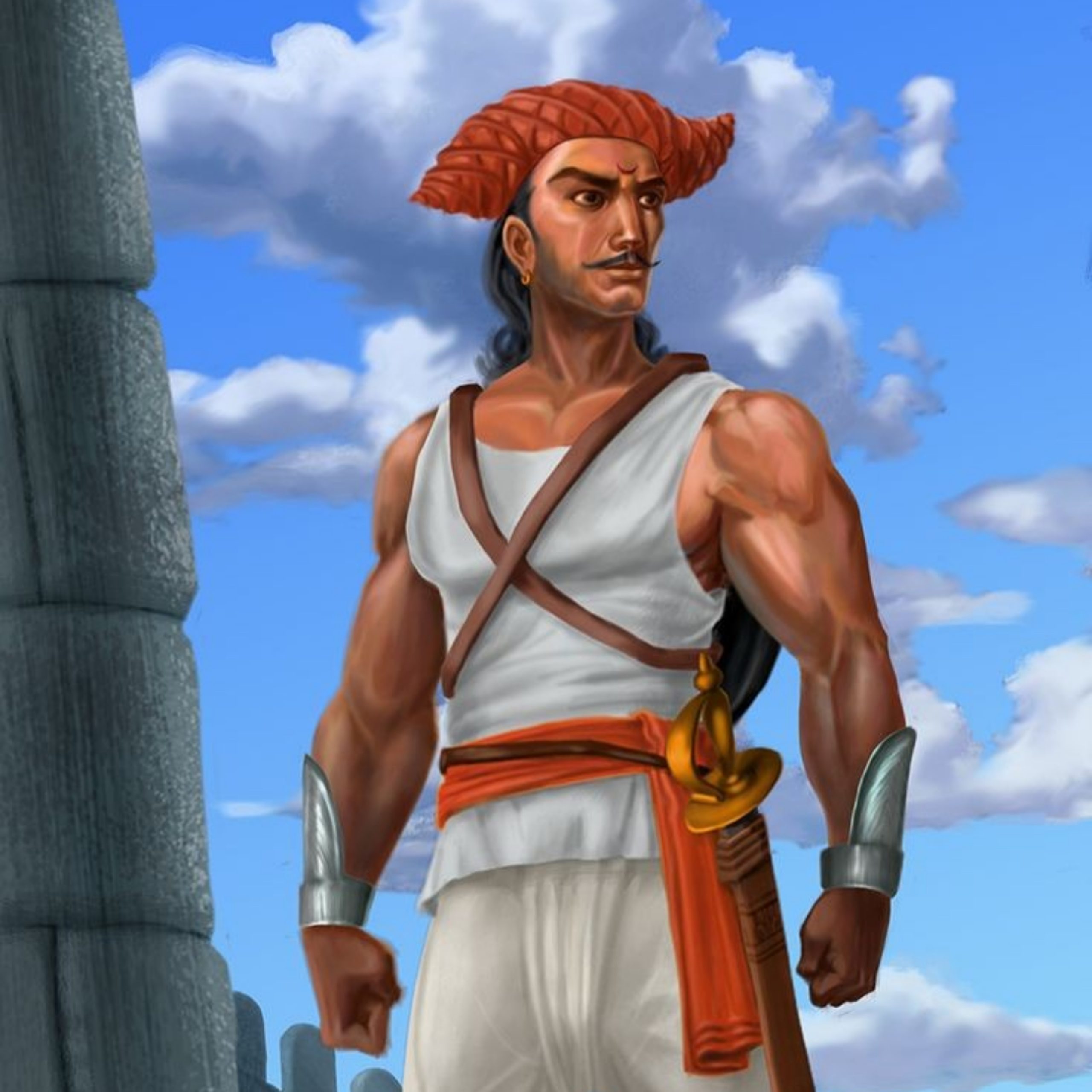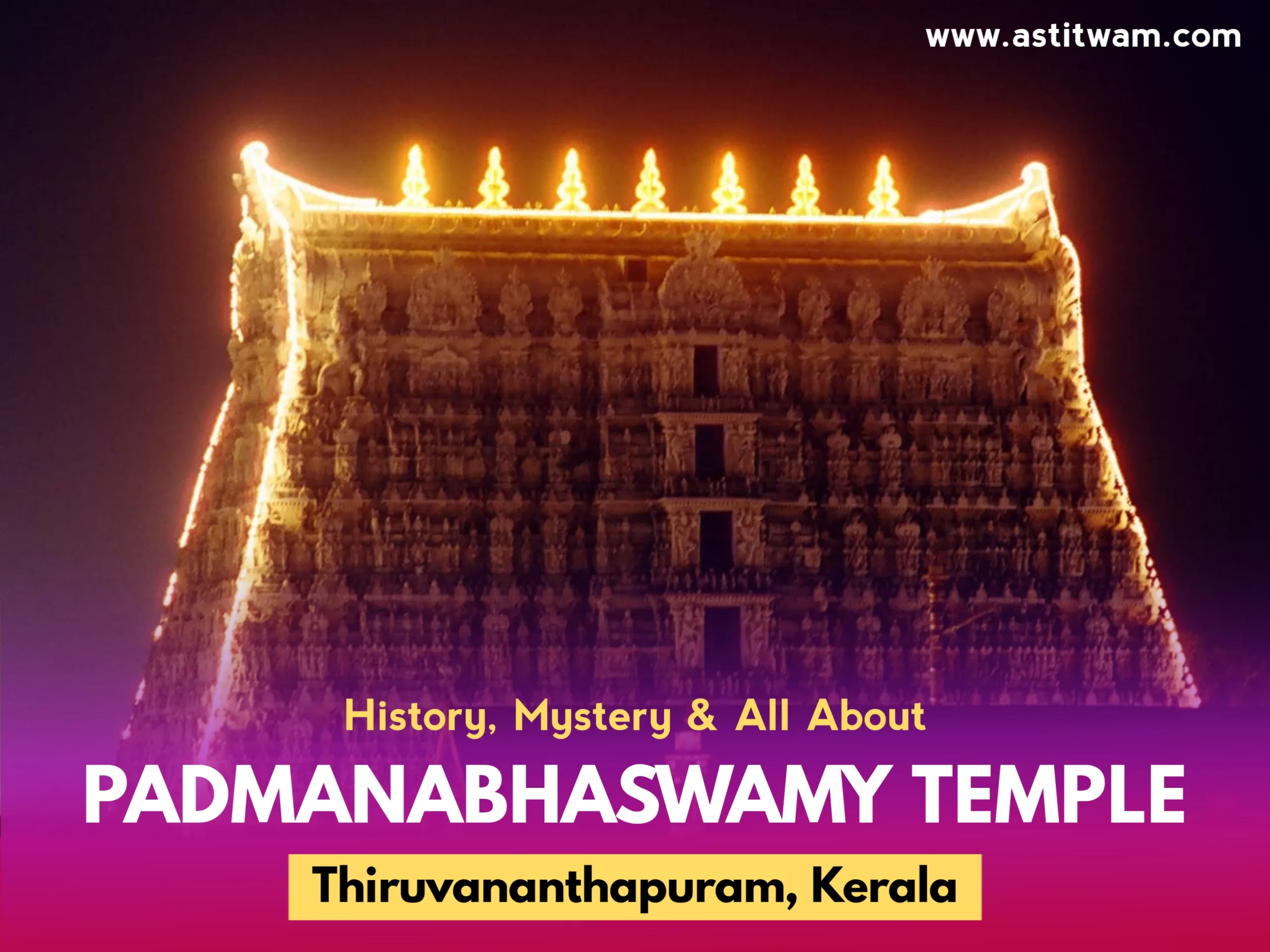Kailasa Temple At Ajanta Ellora Caves: One Of The Largest Cave In India

Table of Contents
Introduction:
The Kailasa or Kailashanatha temple, Ellora Temple, Kailash Caves is the biggest one carved out of rocks among the Hindu temples at the Ajanta Ellora Caves Aurangabad (Verul Aurangabad) now known as Chatrapati Sambhaji Nagar district of Maharashtra, India. This temple is like a huge stone masterpiece, admired worldwide for its size, design, and intricate sculptures. People often call it “the best example of rock-cut architecture in India.” The top of the temple stands 32.6 meters above the ground, and even though the rock slopes downwards from the back to the front, experts believe it was all carved from a single rock.


Among the 34 Hindu, Buddhist, and Jain caves at Ellora, the Kailasa temple (also known as Ellora Cave No 16) is the grandest. These caves stretch over two kilometers along the basalt cliff. It’s mostly thought that the temple was carved out during the time of the eighth-century Rashtrakuta king Krishna I, though some parts might have been finished later. The architecture of the temple reflects influences from the Pallava and Chalukya styles. Inside, there are many large sculptures, though not much remains of the paintings that once adorned the walls. This Kailasa Temple is one of the Heritage Sites In Maharashtra and also a UNESCO World Heritage Site In Maharashtra.

A Glimpse into History of Ajanta Ellora Caves:
The Origins of Kailas Temple
The Kailasa temple, also known as Kailash temple, doesn’t have a written dedication, but it’s widely believed to have been commissioned by a Rashtrakuta king as one of the Rashtrakuta Temples. It’s commonly thought that the temple was built during the reign of King Krishna I, based on two inscriptions linking the temple to a “Krishnaraja.”
One inscription found in a copper plate from Vadodara, dating around 812-813 CE, mentions Krishnaraja as the supporter of the Kailasanatha temple at Ellora. It describes how the king built a remarkable temple that amazed even the gods and the architect. Many scholars think this refers to the Kailasanatha Shiva temple at Ellora. Another inscription, the Kadaba grant of Govinda Prabhutavarsha, also credits Krishnaraja with the temple’s construction.

The Kailasa temple showcases various architectural and sculptural styles, hinting that it might have been built over the reigns of different kings. Some experts think its construction took place under multiple rulers. Certain reliefs in the temple resemble those found in the Dashavatara cave nearby. This cave holds an inscription from Krishna’s predecessor, Dantidurga. Art historian Hermann Goetz suggested that work on the Kailasa temple began during Dantidurga’s rule, with Krishna later completing its initial version, which was smaller than what we see today. Goetz believed Dantidurga’s contributions were downplayed intentionally by Krishna, who aimed to sideline Dantidurga’s sons to secure his own reign.
Goetz also proposed that later Rashtrakuta kings, like Dhruva Dharavarsha, Govinda III, Amoghavarsha, and Krishna III, extended the temple. He suggested that during the 11th century, Bhoja, a Paramara ruler, added the elephant-lion frieze on the lower plinth when he invaded the Deccan region. Additionally, he added new paintings to the temple. Finally, Ahilyabai Holkar commissioned the last layer of paintings in the temple.

M. K. Dhavalikar, in 1982, studied the architecture of the temple and concluded that most of it was constructed during Krishna I’s rule. However, he agreed with Goetz that some parts of the temple could have been built later by other rulers. Dhavalikar identified several components completed by Krishna, including the main shrine, its gateway, the nandi-mandapa, the lower storey, the elephant-lion frieze, the court elephants, and the victory pillars. He acknowledged that the sculpture depicting Ravana shaking the Kailasa mountain, considered one of the finest examples of Indian art, might have been added later. Dhavalikar speculated that this Ellora Sculpture was carved around 3-4 decades after the main shrine was completed, based on its resemblance to the tandava sculpture in the Lankeshvar cave. H. Goetz, however, dated this relief to the reign of Krishna III.
Dhavalikar also attributed some other structures in the temple complex to later rulers, such as the Lankeshvar cave and the shrine of the river goddesses, possibly built during Govinda III’s reign. He theorized that the excavation of the Dashavatara cave, which began during Dantidurga’s reign, was completed during Krishna I’s rule, explaining the similarities between the sculptures in both caves.
However, there’s some uncertainty about attributing the temple solely to Krishna I because these inscriptions aren’t directly linked to the caves, and they don’t provide specific dates for Krishnaraja’s reign. Additionally, the land grants issued by Krishna’s successors don’t mention the Kailasa temple at all.
The Influence of Pallava-Chalukya Dynasties:
Dhavalikar observed that every aspect of the monolithic temple seemed to have been planned from the start, indicating a well-thought-out design process. He noted that the main shrine bears a striking resemblance, albeit on a larger scale, to the Virupaksha Temple in Pattadakal, which itself is modeled after the Kailasa temple in Kanchi. The Virupaksha Temple was built by the Chalukyas of Badami to celebrate their victory over the Pallavas, who originally constructed the Kailasa temple in Kanchi. According to inscriptions from the Virupaksha temple, after defeating the Pallavas, the Chalukyas brought Pallava artists to Pattadakal. Dhavalikar speculated that Krishna, impressed by the Virupaksha Temple, likely brought these skilled artists to his own territory to work on the Kailasa temple at Ellora.

If we assume that the architects of the Virupaksha temple contributed to the construction of the Kailasa temple at Ellora, then building such a massive temple during a single monarch’s reign doesn’t seem far-fetched. These architects would have had a blueprint and a prototype, making the construction process much easier. Additionally, carving a monolithic temple would have been less labor-intensive than transporting large stones for a new temple. Dhavalikar estimated that with around 250 laborers, each capable of cutting about 4 cubic feet of rock per day, the Kailasa temple could have been completed within 5.5 years. The presence of architectural styles from the Chalukya and Pallava dynasties in the temple can be attributed to the involvement of their artists.
Construction Method At Kailasa Temple:
The Kailasa Temple stands out for its unique method of construction—carvers began at the top of the rock and worked their way downwards. The master architect strictly adhered to traditional techniques, which wouldn’t have been possible if they had excavated from the front.
A medieval Marathi tale seems to relate to the temple’s construction. The earliest known mention of this legend is found in Katha-Kalapataru by Krishna Yajnavalki, dating back to the 15th to 16th century. According to the legend, a local king fell seriously ill, and his queen prayed to the god Ghrishneshwar (Shiva) at Elapura for his recovery. She vowed to build a temple if her wish was granted and promised to fast until she could see the temple’s top.

After the king was healed, she urged him to construct the temple immediately, but architects estimated it would take months to complete, including the top. However, an architect named Kokasa assured the king that the queen would see the top of a temple within a week. He began construction from the top by carving into a rock and managed to finish the top within the promised time, allowing the queen to end her fast.
The temple was then named Manikeshwar after the queen. M. K. Dhavalikar suggests that Kokasa might have been the main architect of the Kailasa temple, possibly originally known as Manikeshwar. Several 11th-13th century inscriptions from central India mention architects from Kokasa’s prestigious family.
The Architectural Extravaganza: Marvels of Kailas Temple’s Design
The architectural brilliance of the Kailas Temple leaves visitors spellbound. This section takes a close look at the temple’s layout, exploring the various components that make it an engineering and artistic marvel. From the iconic monolithic chariot that serves as the main shrine to the intricate colonnades, statues, and relief carvings that adorn its walls, we unveil the secrets behind the temple’s awe-inspiring design of the Single Stone Temple In India.

Sculpting Divinity: The Mesmerizing Carvings of Kailas Temple
The architecture of the Kailasa temple sets it apart from the earlier styles found in the Deccan region. Although it draws inspiration from the Virupaksha Temple in Pattadakal and the Kailasa temple in Kanchi, it isn’t an exact copy of either. The influence of the Chalukya and Pallava artists involved in its construction brought a distinct southern touch to the temple’s design. It seems that the local Deccan artisans played a lesser role in its creation.
At the entrance to the temple courtyard stands a low gopuram. On the left side of the entrance, most of the deities are Shaivaite, associated with Shiva, while on the right side, the deities are Vaishnavaites, associated with Vishnu. Beyond the entrance lies a U-shaped courtyard measuring 82 meters by 46 meters at its base. Surrounding the courtyard is a three-story high columned arcade adorned with large sculpted panels and alcoves housing enormous deity sculptures. Originally, stone bridges connected these galleries to the central temple structures, but these have since collapsed. Some of the most renowned Ellora Caves Sculptures within include depictions of Shiva as an ascetic, Shiva as a dancer, Shiva being warned by Parvati about the demon Ravana, and various river goddesses.
The Kailas Temple is dedicated to Lord Shiva, one of the most revered deities in Hinduism. In this part, we delve into the temple’s spiritual significance, tracing the connections between its architectural elements and Hindu religious beliefs. We explore the symbolism behind the sacred Mount Kailash, the river Ganga, and the various manifestations of Lord Shiva present in the temple’s intricate carvings.
The Central Shrine and Nandi Mandapa of the Kailasa Temple:

In the temple courtyard, there’s a central shrine devoted to Shiva, along with an image of his mount Nandi, the sacred bull. The main shrine housing the lingam has a flat-roofed mandapa supported by 16 pillars and a Dravidian shikhara. It includes various features like pillars, windows, inner and outer rooms, assembly halls, and a massive stone lingam at its center. The shrine is adorned with niches, plasterwork, windows, and sculptures of deities, mithunas (erotic male and female figures), and other characters. Following the tradition of Shiva temples, Nandi sits on a porch in front of the main temple. Both the Nandi mandapa and the main Shiva temple are around 7 meters tall, built on two levels. The lower levels of the Nandi Mandapa are solid structures embellished with intricate carvings. The temple’s base gives the impression of elephants supporting the structure. A stone bridge links the Nandi Mandapa to the temple porch. The temple hall’s base depicts scenes from the Mahabharata and Ramayana.
Engineering Marvels: Carving Kailas Temple from Stone
Constructing the Kailas Temple presented immense challenges for the ancient architects and craftsmen. This section explores the ingenious engineering techniques employed to carve the temple from Charanandri Hill’s volcanic rock. From the usage of primitive tools to the brilliance of rock-cut architecture, we shed light on the technological feats that made this colossal task possible.

The Kailas Temple’s survival through centuries is a testament to the resilience of both the structure and the community that cared for it. In this part, we examine the temple’s journey through various historical periods, including times of decline, restoration, and recognition as a UNESCO World Heritage Site. We also discuss the ongoing efforts to preserve and protect this invaluable heritage.
The allure of the Kailas Temple extends beyond India’s borders, captivating travelers, historians, and artists from around the world. In this segment, we explore the temple’s impact on international art, architecture, and cultural exchange, celebrating its status as a global treasure.
Conclusion:

In conclusion, the Kailasa Temple stands as a testament to the remarkable fusion of architectural brilliance and spiritual devotion. Its distinctive design, influenced by both southern styles and Hindu religious beliefs, sets it apart from other temples in the Deccan region. From its vertical excavation to its intricate sculptures depicting various deities and mythological scenes, every detail of the temple reflects a deep reverence for Lord Shiva and the rich cultural heritage of India.
As visitors enter the temple courtyard through the low gopuram, they are greeted by a mesmerizing array of sculptures and carvings, each telling a story of devotion and divine intervention. The presence of both Shaivaite and Vaishnavite deities symbolizes the unity and diversity inherent in Hinduism, while the grandeur of the U-shaped courtyard and towering columned arcade evokes a sense of awe and reverence.
At the heart of the temple lies the central shrine dedicated to Lord Shiva, surrounded by his faithful mount Nandi and adorned with intricate carvings depicting scenes from Hindu epics. Here, amidst the sacred atmosphere of the temple, visitors are invited to contemplate the deeper spiritual significance of Mount Kailash, the abode of Lord Shiva, and the eternal flow of the river Ganga, symbolizing purity and divine grace.
Also Know About: Sree Padmanabhaswamy Temple | Thiruvananthapuram, Kerala
In essence, the Kailasa Temple transcends mere architectural marvel to become a sacred space where devotees can connect with the divine and experience a profound sense of peace and spirituality. As a testament to the enduring legacy of Hinduism and the creative genius of ancient artisans, it continues to inspire awe and reverence in all who visit, reaffirming its status as one of India’s most revered cultural treasures.


